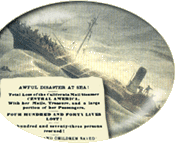

 |
 |

|
By Friday morning, September 11, the crew was still in control, but the steamer had begun to take on water through the drive shaft, broken or open lights (windows to illuminate the below-deck areas), and elsewhere. The ship was tossing violently, making it virtually impossible to feed coal into the boilers. At 11 a.m. Captain Herndon told the passengers that the ship was in danger and enlisted the aid of all men to bail water with a bucket brigade. By 1:00 in the afternoon the rising water in the hold had quenched the boiler fires, and the ship's immense paddlewheels came to a halt. The SS Central America was at the mercy of the sea. Disaster By mid-afternoon, the
lower deck and many cabins of the SS Central America
were uninhabitable. After a tumultuous wind- and wave-whipped night, the powerless Central America wallowed helplessly in a raging sea on Saturday morning, September 12, 1857. Decks were awash. Capt. Herndon ordered the American flag to be flown upside-down as a distress signal. The Atlantic coastal route was well traveled, and surely it would be a short time until other ships came along. HopeGood news finally arrived. By 10:00 a.m. the hurricane showed signs of abating. The worst was over. However, too much damage had already been done to save the ship. Water continued to fill what air spaces remained in the cabins and compartments in the wooden hull, and it seemed clear that the SS Central America had but a short time left. Abandon ship! At about 1:00 p.m. on
Saturday afternoon, the sail of the brig Marine was
seen on the horizon. The storm-damaged vessel, under the
command of Captain Hiram Burt and ten crew members, drew
closer. Aboard the sinking SS Central America
The first lifeboat leaving the SS Central America was smashed, and the women and children experienced difficulties as they climbed into the small boats. Some were lowered in hastily fashioned rope loops or nooses in which they sat, but most jumped from the Central America into the boats below. Some missed the target and landed in the sea, and were fished out by those already in the little vessels. In the coming hours, the storm-damaged brig Marine had dozens aboard. One hundred nine passengers were saved in nine shuttle trips. The Marine eventually drifted several miles away and could no longer render aid. The Central America continued to fill with water. By now, all bailing efforts had ceased and most of the ship was inundated. Pounding waves broke up cabin walls and floors and tore away sails, spars, and equipment. Some of the men ripped planks and railings off the ship to make crude rafts, while others found single boards on which to float. The last moments of the Central America
Soon thereafter the Central America came to rest in the darkness 8,000 feet below the surface, about 160 miles offshore from Charleston, South Carolina. Passenger gold was scattered here and there around the ship's hulk and the surrounding sea bottom. In the hold, still stored in the wooden boxes that had been carried along the Pacific Coast by the Sonora, the treasure of gold coins and ingots remained intact. At the final reckoning of the SS Central America disaster, about 425 lives were lost. Only 153 were saved.
News of the tragedyFor many weeks accounts of the disaster were carried in newspapers as passengers were rescued and brought to various ports. In time, the lost treasure ship and its passengers were largely forgotten. Indeed, even authoritative almanacs and anthologies of disasters and shipwrecks often omitted mention of the sinking of the SS Central America despite its being the greatest American peacetime maritime disaster up to that point.
|
||||||||||